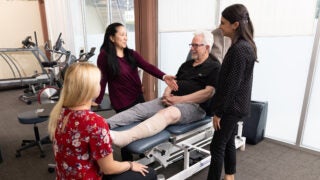As Women’s History Month begins, USC researchers reflect on women’s achievements and challenges
USC experts highlight the continuing struggle for women’s equal rights and the legacy of the trailblazing women who have transcended gender barriers to contribute to a more perfect — and equal — union.
Since 1987, the U.S. Congress has designated March as Women’s History Month, a time to commemorate and recognize the key role of women in American history — and to encourage the study, observance, and celebration of that history.
During Women’s History Month and beyond, USC experts will engage with the continuing struggle for women’s rights and the legacy of the trailblazing women who have transcended gender barriers to contribute to a more perfect — and equal — union.
Women’s history offers a lesson in what progress looks like
“The COVID-19 pandemic has disproportionally affected women — at home and in their jobs — and it has affected their health,” said Parveen Parmar, associate professor of clinical emergency medicine, chief of the Division of Global Emergency Medicine and director of the Center for Gender Equity in Medicine and Science at the Keck School of Medicine of USC. “Women’s History Month reminds us that women have made great progress despite so many challenges.”
But Karen Tongson notes that progress isn’t measured in a straight line. The professor of English, gender and sexuality studies, and American studies and ethnicity, and chair of the Department of Gender and Sexuality Studies at the USC Dornsife College of Letters, Arts and Sciences said one thing she has learned from her research is “things don’t consistently get better.”
Tongson cites the example of reproductive health freedoms, which expanded in the 1970s only to now face challenges as state legislatures propose more restrictions and the U.S. Supreme Court appears poised to strike down Roe v Wade.
“Part of what we learn is how to move through these different cycles of change and transformation and how to keep the momentum going, even when sometimes the task can feel Sisyphean,” she said. “We need to celebrate these achievements and ‘firsts’ because there’s always going to be more work to do.”
The next frontier of the women’s movement: Valuing care work
“Reflecting on Women’s History Month, it is clear the women’s movement has been successful in terms of freeing women to move from the domestic sphere into public life,” said Darby Saxbe, associate professor of psychology and director of the USC Dornsife Center for the Changing Family.
Compared with 50 years ago, she said, there has been a staggering shift in terms of women’s participation in the workforce. But she believes there have been some unintended consequences, including neglecting the work of caring for others.
“Our individualistic society has always undervalued care labor, and the monumental amount of unpaid care labor that women have done historically has been undercompensated and overlooked,” she said.
Saxbe points to the backsliding in women’s employment gains during the COVID-19 pandemic. There were 1.8 million fewer U.S. women working in October 2020 than in February 2020, according to Bureau of Labor Statistics data. Economists pointed out that American women’s labor force participation had fallen to levels not seen in more than 30 years.
“Suddenly, the institutions and structures that help support families — day cares, public schools and nursing homes — closed and everything rebounded back into the home,” Saxbe said. “Women were the ones who disproportionately left the workforce or scaled back their work hours to care for children and elders.”
The next frontier of the women’s movement, Saxbe said, should be valuing such traditionally feminine pursuits with better pay for caring professions and policies like parental leave. It would include a shift away from focusing on what women should do differently, to a closer look at how men are contributing to both work and home life.
“In a progressive society where care work and domestic labor are just as valued and just as respected as business careers or STEM careers, we could celebrate when women — and men — contribute to building a more nurturing society,” she said.
Who sits in the director’s chair?
Artistic contributions are another important part of women’s history. But USC researchers with the USC Annenberg Inclusion Initiative have found that women — particularly women of color — are making slow progress in important sectors of the entertainment industry.
A new report by Stacy L. Smith, Katherine Pieper and Al-Baab Khan looked at the gender, race and ethnicity of directors of the 100 top U.S. films each year from 2007 to 2021. They found that while white women and men of color have seen increased opportunities, this trend did not extend to women of color.
Only five women of color directed a top-grossing film between 2020 and 2021, and fewer than 2% of all directors across 15 years were women of color — even though women of color earned the best critical reception for their work. The researchers say the results suggest that the “quality that women of color bring to filmmaking is not an explanation for their lack of participation in top-grossing films.”
To help address this inequity, the Inclusion Initiative recently launched a program to award a $25,000 scholarship to a woman of color to use for expenses related to creating a student film during her senior year at a U.S. film school.
Reacting to a historic Supreme Court nomination
Women, in particular women of color, have also been underrepresented on the nation’s highest court. Just days ago, President Joe Biden delivered on a campaign promise to nominate a Black woman to the U.S. Supreme Court. If confirmed, Judge Ketanji Brown Jackson would be the sixth woman and the first Black woman to sit on the bench in the court’s 233-year history.
“Judge Ketanji Brown Jackson, if confirmed to the Supreme Court, will help diversify an institution in which Black women have, through law, custom and practice, been excluded for over two centuries,” said Franita Tolson, professor of law and vice dean for faculty and academic affairs at the USC Gould School of Law.
Tolson points to the nominee’s “top-notch” credentials as a double Harvard University graduate, former Supreme Court clerk, former district court judge and current circuit court judge.
“She also brings a credential to the court that is lacking among the current personnel: She is a former public defender,” Tolson said. “It is clear that Judge Jackson is a highly qualified nominee who will bring a diverse set of experiences to the Supreme Court.”
Women in the military and as advocates for peace
Women’s History Month shines a light on how women continue to break barriers in previously male-dominated professions, including in the military. In 1973, when military conscription ended, women constituted 2% of the active-duty military. Now, 16% of current active-duty military members are women, a fact that has changed the culture of both the military itself and the veteran population.
“In my recent research on U.S. military veterans’ peace organizations, I witnessed a younger cohort of women — many of them women of color, some queer-identified — emerging as leaders,” said Michael Messner, a professor of sociology and gender studies at the USC Dornsife College.
Messner’s research found women veterans had experienced trauma from sexual and gender harassment, sexual assault and racist and homophobic abuse during their military service — some of it while serving in combat zones. They used these experiences to transform the veterans’ peace movement, “linking anti-militarist work with movements for racial justice, stopping gender and sexual violence, addressing climate change, and building anti-colonial coalitions,” said Messner, whose new book is titled Unconventional Combat: Intersectional Action in the Veterans’ Peace Movement.
“Through this work, they bend the arc of history toward peace and social justice,” he added.
What history do we want to make?
“Women’s History Month shows us the different sacrifices our forebears have made,” said Tongson, the chair of the Department of Gender and Sexuality Studies at USC Dornsife. “They’ve managed to transform worlds and cultures that were often hostile to them. We can use that example to fortify our efforts to change and transform our roles and to make things better — to make what seemed impossible, achievable.”



